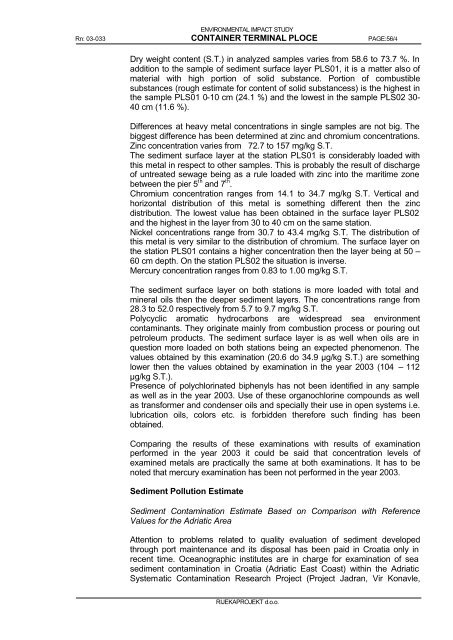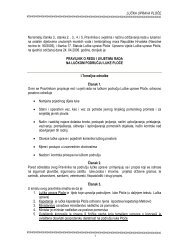HEADING PAGE - port of ploce authority * welcome
HEADING PAGE - port of ploce authority * welcome
HEADING PAGE - port of ploce authority * welcome
You also want an ePaper? Increase the reach of your titles
YUMPU automatically turns print PDFs into web optimized ePapers that Google loves.
ENVIRONMENTAL IMPACT STUDY<br />
Rn: 03-033 CONTAINER TERMINAL PLOCE <strong>PAGE</strong>:56/4<br />
Dry weight content (S.T.) in analyzed samples varies from 58.6 to 73.7 %. In<br />
addition to the sample <strong>of</strong> sediment surface layer PLS01, it is a matter also <strong>of</strong><br />
material with high <strong>port</strong>ion <strong>of</strong> solid substance. Portion <strong>of</strong> combustible<br />
substances (rough estimate for content <strong>of</strong> solid substancess) is the highest in<br />
the sample PLS01 0-10 cm (24.1 %) and the lowest in the sample PLS02 30-<br />
40 cm (11.6 %).<br />
Differences at heavy metal concentrations in single samples are not big. The<br />
biggest difference has been determined at zinc and chromium concentrations.<br />
Zinc concentration varies from 72.7 to 157 mg/kg S.T.<br />
The sediment surface layer at the station PLS01 is considerably loaded with<br />
this metal in respect to other samples. This is probably the result <strong>of</strong> discharge<br />
<strong>of</strong> untreated sewage being as a rule loaded with zinc into the maritime zone<br />
between the pier 5 th and 7 th .<br />
Chromium concentration ranges from 14.1 to 34.7 mg/kg S.T. Vertical and<br />
horizontal distribution <strong>of</strong> this metal is something different then the zinc<br />
distribution. The lowest value has been obtained in the surface layer PLS02<br />
and the highest in the layer from 30 to 40 cm on the same station.<br />
Nickel concentrations range from 30.7 to 43.4 mg/kg S.T. The distribution <strong>of</strong><br />
this metal is very similar to the distribution <strong>of</strong> chromium. The surface layer on<br />
the station PLS01 contains a higher concentration then the layer being at 50 –<br />
60 cm depth. On the station PLS02 the situation is inverse.<br />
Mercury concentration ranges from 0.83 to 1.00 mg/kg S.T.<br />
The sediment surface layer on both stations is more loaded with total and<br />
mineral oils then the deeper sediment layers. The concentrations range from<br />
28.3 to 52.0 respectively from 5.7 to 9.7 mg/kg S.T.<br />
Polycyclic aromatic hydrocarbons are widespread sea environment<br />
contaminants. They originate mainly from combustion process or pouring out<br />
petroleum products. The sediment surface layer is as well when oils are in<br />
question more loaded on both stations being an expected phenomenon. The<br />
values obtained by this examination (20.6 do 34.9 µg/kg S.T.) are something<br />
lower then the values obtained by examination in the year 2003 (104 – 112<br />
µg/kg S.T.).<br />
Presence <strong>of</strong> polychlorinated biphenyls has not been identified in any sample<br />
as well as in the year 2003. Use <strong>of</strong> these organochlorine compounds as well<br />
as transformer and condenser oils and specially their use in open systems i.e.<br />
lubrication oils, colors etc. is forbidden therefore such finding has been<br />
obtained.<br />
Comparing the results <strong>of</strong> these examinations with results <strong>of</strong> examination<br />
performed in the year 2003 it could be said that concentration levels <strong>of</strong><br />
examined metals are practically the same at both examinations. It has to be<br />
noted that mercury examination has been not performed in the year 2003.<br />
Sediment Pollution Estimate<br />
Sediment Contamination Estimate Based on Comparison with Reference<br />
Values for the Adriatic Area<br />
Attention to problems related to quality evaluation <strong>of</strong> sediment developed<br />
through <strong>port</strong> maintenance and its disposal has been paid in Croatia only in<br />
recent time. Oceanographic institutes are in charge for examination <strong>of</strong> sea<br />
sediment contamination in Croatia (Adriatic East Coast) within the Adriatic<br />
Systematic Contamination Research Project (Project Jadran, Vir Konavle,<br />
RIJEKAPROJEKT d.o.o.



